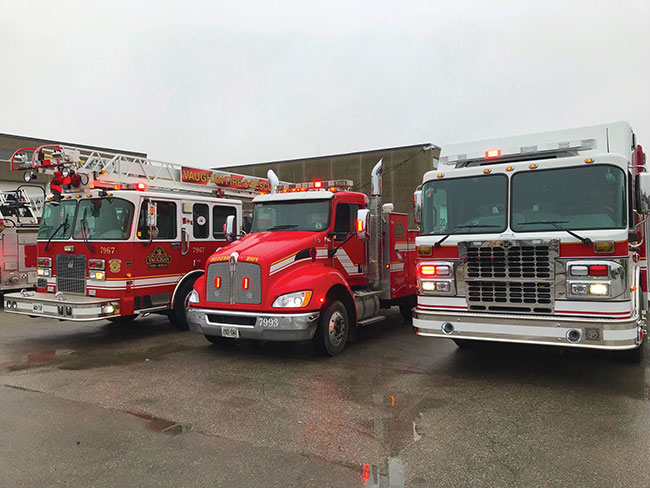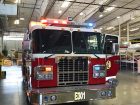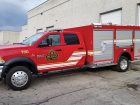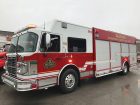
Equipment
New products
Truck Tech: November 2018
Hope everyone had a great, safe and healthy summer. The long, cold winter is now just around the corner. With that in mind, I’d like to take the opportunity to write about preparing for the cold weather.
October 23, 2018
By Chris Dennis

If you live in a house on a lot, that usually means preparing and storing items for the winter, like lawn furniture, patio items, umbrellas, the lawnmower, gas-power trimmer, garden hose, sprinklers and all other warm-weather-related items so they are good to go again in the spring.
Gas-powered equipment on our fire trucks must also be prepared for the cold months and terrible weather.
The summer fuel that you have been using from the pumps should be replaced with winter fuel. Octane and additives in the summer gas do not like cold temperatures.
This, in turn, holds true from winter gasoline into the summer months. Pour what residual four-stroke fuels you have on the trucks, saws and generators, etc. into the gasoline-powered vehicles in the fleet. Once the portable fuel cans and gas-powered equipment are clear of summer fuel then add some fuel stabilizer to the gas cans and in the tools themselves. Pour a thimble-full into the tools and/or follow manufacturers’ suggested rules for adding stabilizer to their products. Now, top up the gas cans and tools with fresh fuel for the winter.
If you are a busy station and go through a lot of remote gas, don’t worry about the time that the fuel sits in the equipment and in the cans. It will not have time to separate. If the gas cans and tools sit at the ready most of the time, then be sure to exercise them as often as possible. You may even have to drain out the gas in the tool and cans again partway through the winter and replace with fresh gas.
Fuel stabilizer does just that. It stabilizes the gas and boosts octane and prevents the gas from separating. This is a common issue with winter gasoline or gas with methanol in it. Check the company you gas-up with and see what is in the gasoline it pumps during winter operations .
Cars and trucks going up and down the road go through gas quickly, so the chance of separating is small to none unless you vacation for most of the winter.
Two-stroke engines and fuel mixtures need the same attention. Disposal of pre-mixed fuel is a bit more difficult. If you are using a store-bought, over-the-counter, de-cantered, two-stroke product then no worries. Depending on which product it is, the shelf life of a closed container could be up to five years while opened containers in use can last up to two years on the shelf. A couple of name-brands that I am familiar with are TruFuel and a STIHL product called MotoMix.
If you do these relatively inexpensive and non-time-consuming duties to the gasoline and your gas-powered equipment, they won’t let you down this winter.
I would also suggest checking the air filters and changing the sparkplugs, if this has not been done. An average filter costs $6 to $15, depending on the manufacturer, and sparkplugs start at approximately $3 and go up from there.
In Vaughan, we do not use iridium or high-end sparkplugs. However, the better the plug the less often you need to remove and replace it. That being said, why would you not go that way? My reasoning is that if you never have to take something out to inspect it or clean it, how will you know a potential problem is looming?
Changing engine oil and filters is also important. If your equipment has a gasoline shutoff, turn it off as well. This will prevent engine oil crankcase gasoline contamination. When left on all the time, there is a higher risk of gasoline bypassing in the carburetor and running into the crankcase. This will ruin engine oil and possibly prevent the engine from starting and possibly backfiring. Gasoline-contaminated oil takes the lubricity out of the oil, damaging moving engine parts due to poor lubrication.
If the apparatus has an enclosed Canadian fire pump heating package, make sure the heat pans are on. If the truck was not built with this feature, you may possibly want to investigate having it installed. The underside of the fire pump is encapsulated and a remote heater is added into the pumphouse module to keep the fire pump warm. The heater is hooked up in-line with the fire truck cab heater system coolant lines. Assuming the truck has this feature, don’t forget to make sure the heaters installed work and there are no leaks.
Pressure-test the cooling system and check for all anti-freeze leaks and repair if needed. If a top-up is required, do not add 100-per-cent concentrated anti-freeze. Pre-mix it 50/50. Be sure not to mix long-life pink anti-freeze with any other. One-hundred-per-cent-concentrated anti-freeze will eventually plug up the cooling system then contaminate it as well and allow the engine to overheat. If the pumphouse heater is on a thermostat, set it to max and/or just turn the blower switch on and leave it on all winter.
Depending on road de-icing products in your province, corrosion may not be a problem. In Vaughan, it will corrode the seat base inside the cab if I leave it on long enough. The brine in our municipality continues to work away at ruining electrical items long into the nice weather. The heater-blower motors are not protected inside the pumphouse from the elements. Be sure to turn them on before it’s cold. Be sure fire pump drains are free and working correctly. Make a mental note of how well they function so, in the dead of winter, they are not forced open. Better to leave a frozen drain shut than force it open.
Empty each compartment one by one. Then, using a mild soap and water solution, clean them out to have a fresh start for the winter. Do not power wash, especially if there are electrical wires in these compartments. Look at the kits in each compartment. The door seals, whether they’re roll-up or swing, can be cleaned and sprayed with a dry silicone, making them slippery and soft. Lubricate all D-handle latches or locking-latching mechanisms. Repair any damages to the compartment doors. If drain holes are not in the compartment, a shop-vac is handy.
If the truck is an aerial, clean and lubricate the ladder as per OEM recommendations, and do that again in the spring. We don’t pay much attention to aluminum and steel aerial ladders, but a dirty ladder will fail and let you down, making for an expensive repair.
In Vaughan, our crews do the job. We have had ladders refurbished over the years and have been told by the manufacturers that they are still in great shape 10 to 15 years after they’ve been purchased. It’s worth the maintenance. All ground ladders should be removed, cleaned and inspected.
Next, lift the cab or tilt the hood and check the anti-freeze condition and strength. A sample of coolant can be taken to a local repair shop to be tested while you wait.
Check the belts, engine oil, power-steering transmission oil level if the vehicle is automatic, and air filter. It’s best to remove it and inspect. We recently replaced an air filter that was only six months old. It got wet, allowing the element to separate and tear open. So, even if a replacement date was recent, give it a check.
Add fluids as required or change outright. A volunteer fire station we look after for repairs, changes the engine oil and filters, including fuel filters, on its trucks once a year no matter what.
Don’t forget to check the cab and pay attention to all lighting, especially the lenses. If they are cracked or show signs of problems, make repairs. Once water gets into them, even LED lights, all warranties are off and the light will fail. The cost of LED lights is super-expensive. At times, it’s cheaper to buy the whole light rather than just the lenses. The lenses do break, however, usually from being hit by a wash brush or from over-tightening. Once the truck is back on the road, the lenses vibrate and twist and crack.
It’s a simple thing, but dealing with corroded wiring sooner rather than later will save you big money and possibly downtime.
Cab doors, latches and window cranks should be lubricated with light oil. Lube everything from the outside door handles and latches to natter bolts. Use dry silicone spray and don’t forget the window channels.
It costs approximately $30,000 to have a custom fire truck painted correctly, with a three-to-five-year warranty. Waxing will slow down the chances of having to paint a truck before it’s retired.
Enjoy the winter and all that goes with it. And remember to stay safe and keep the rubber side down.
Chris Dennis is chief mechanical officer for Vaughan Fire & Rescue Service in Ontario. He can be reached at Chris.Dennis@vaughan.ca.
Print this page



